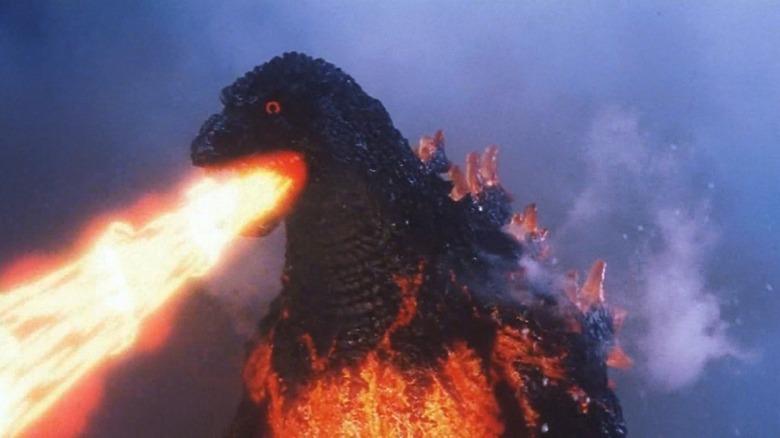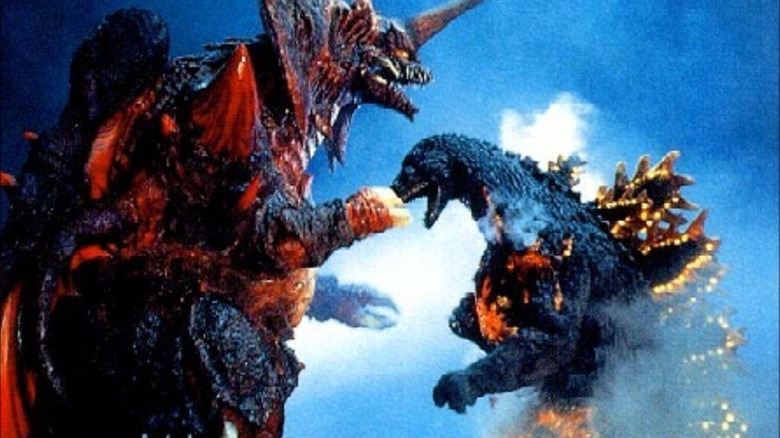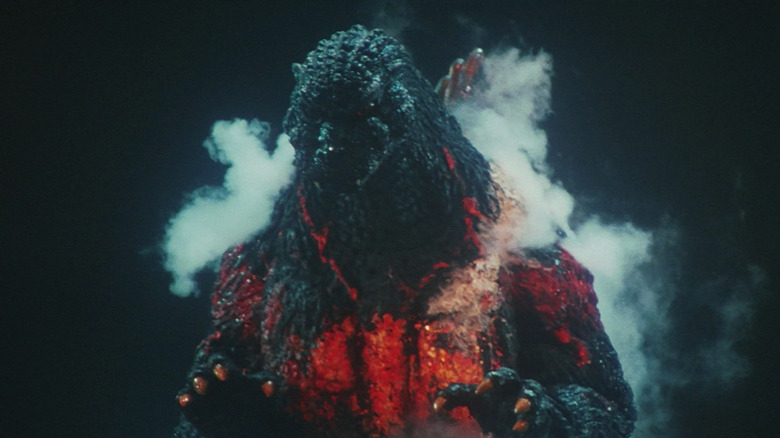Only One Godzilla Movie Currently Boasts A Perfect Critic's Score On Rotten Tomatoes
Takashi Yamazaki's "Godzilla Minus One" was an unexpectedly large hit in the United States, and currently holds the distinction of being the highest-grossing Japanese-language Godzilla film in U.S. box office history. "Minus One" is also unique in the Godzilla canon in that it affects an optimistic worldview. Several Godzilla movies in the franchise tended to zero in on Godzilla's horrifying nuclear origins, pointing out that the monster is the direct result of atomic testing. Humans were only able to destroy Godzilla in Ishiro Honda's 1954 film "Gojira" by creating a new weapon even more devastating than the atomic bomb. That film is sad and dour and pessimistic. In contrast, "Godzilla Minus One" is about how ingenuity and redemption are still possible after World War II, and that humans needn't be hopeless or obsessed with death. It's okay, "Minus One" argues, to let go of the violence.
"Minus One," however is the 38th film in the franchise, and Godzilla has experienced a lot of highs and lows since 1954. Indeed, Godzilla is currently in its fourth era, and has gone through at least eight or nine unique continuities (more, depending on how one interprets the interconnectivity in the Millennium Era).
From 1984 through 1995, Godzilla went through the Heisei era, a rebooted continuity that began with "The Return of Godzilla" (released as "Godzilla 1985" in the United States). "Return" was a direct sequel to the 1954 original and ignored the intervening 14 films made up until 1975. Godzilla was bigger, meaner, and more destructive. The Heisei era also — and this is significant — rewrote Godzilla's origin. The Heisei Era concluded spectacularly with the only Godzilla film to have a 100% approval rating on Rotten Tomatoes: Takao Okawara's 1995 finale "Godzilla vs. Destoroyah."
Godzilla vs. Destoroyah
Full disclosure: "Godzilla Minus One" currently has a Rotten Tomatoes approval rating of 98%, a number which is extrapolated on 171 submitted reviews. Only four critics submitted "rotten" reviews of "Minus One," including Louisa Moore, Roger Moore (no relation), Adam Olinger, and Esmé Holden. "Godzilla vs. Destoroyah" may have a 100% approval rating, but that number is based on only six reviews ... and I wrote one of them.
Despite the technicality, though, "Destoroyah" still holds the highest Rotten Tomatoes rating; no one has yet been passionate enough to write a scathing counterpoint to any of the posted reviews. One can argue all day as to which Godzilla movie is the best, but "Destoroyah" has a legitimate claim to that title. It possesses the raucous destructive spirit of the late '60s Godzilla films, but also a sense of operatic grandeur. Which is appropriate, given that "Destoroyah" was intended to be a farewell.
The story is epic: Godzilla, Jr., a monster introduced in 1993's "Godzilla vs. Mechagodzilla II," is now growing to Godzilla size and looking a lot more like the original monster. Godzilla himself, meanwhile, has become dangerously radioactive. This Godzilla is powered by an internal nuclear fire, and that fire has only been growing over the years. Godzilla now glows red hot and smoke pours out of his skin. If Godzilla gets too hot, he will explode like a nuclear bomb and kill all living things on Earth.
Humans attempt to use a weaponized airship called the Super X-III, which has been equipped with, essentially, a freeze ray. The Super X-III is able to slow Godzilla, but his nuclear fire continues to burn. The first Super X appeared in "The Return of Godzilla," while a reflective Super X-II appeared in "Godzilla vs. Mechagodzilla II."
Godzilla melts down like a dang Viking
Meanwhile, several unusual Precambrian creatures appear out of the sea. It seems that the Oxygen Destroyer — the weapon used to kill the original Godzilla in 1954 — has infected some of the local wildlife, causing it to grow and mutate. Just as Godzilla was born of nuclear radiation, the new monsters are born of the Oxygen Destroyer. These new monsters are essentially Godzilla's arch-nemesis, constructed of the very substance/radiation that was designed to destroy him. As the film progresses, the monsters get bigger and begin to combine until they form a massive winged bipedal bug/lobster called Destoroyah.
The original plan was to call the film "Godzilla vs. Destroyer," but Toho found they couldn't copyright the word "Destroyer" — perhaps KISS already had a claim — so they renamed the monster "Destoroyah" for legal reasons.
The final fight involved Godzilla, Jr. and Godzilla's eventual meltdown from his internal heat. Godzilla is not killed by a rival, but destroyed from within, too badass to live. It's implied, however, that Godzilla, Jr. will merely take the original Godzilla's place, allowing the litany of destruction to continue.
Sadly, there were no direct sequels to "Destoroyah," and Toho was ready to hand their Godzilla rights over to TriStar Pictures for an intended trilogy of American Godzilla films. I think we all remember how that deal turned out. Toho would, instead, make a trilogy of Power-Rangers-like, kid-friendly Mothra films that are great for anyone under the age of 10. When the 1998 American "Godzilla" tanked, Toho brought back the G-Man with "Godzilla 2000," the first of the six-film Millennium Era.
That era ended in 2004. There have been 11 Godzilla films since (if one counts "Kong: Skull Island").


